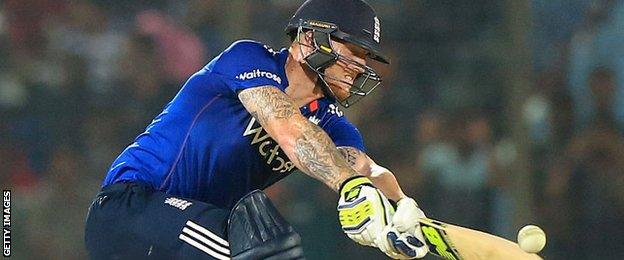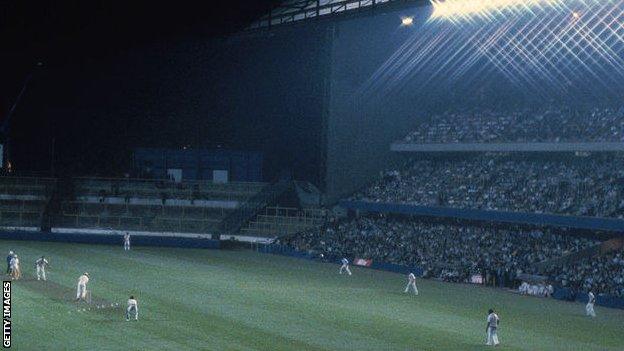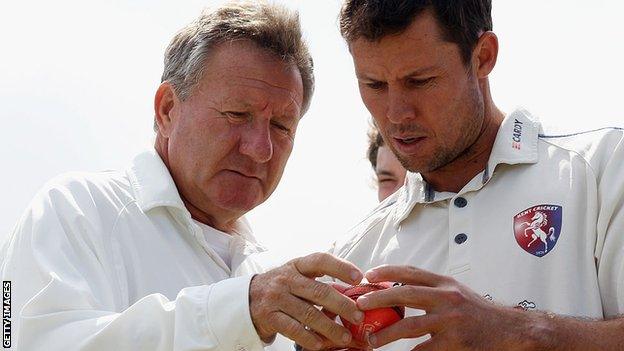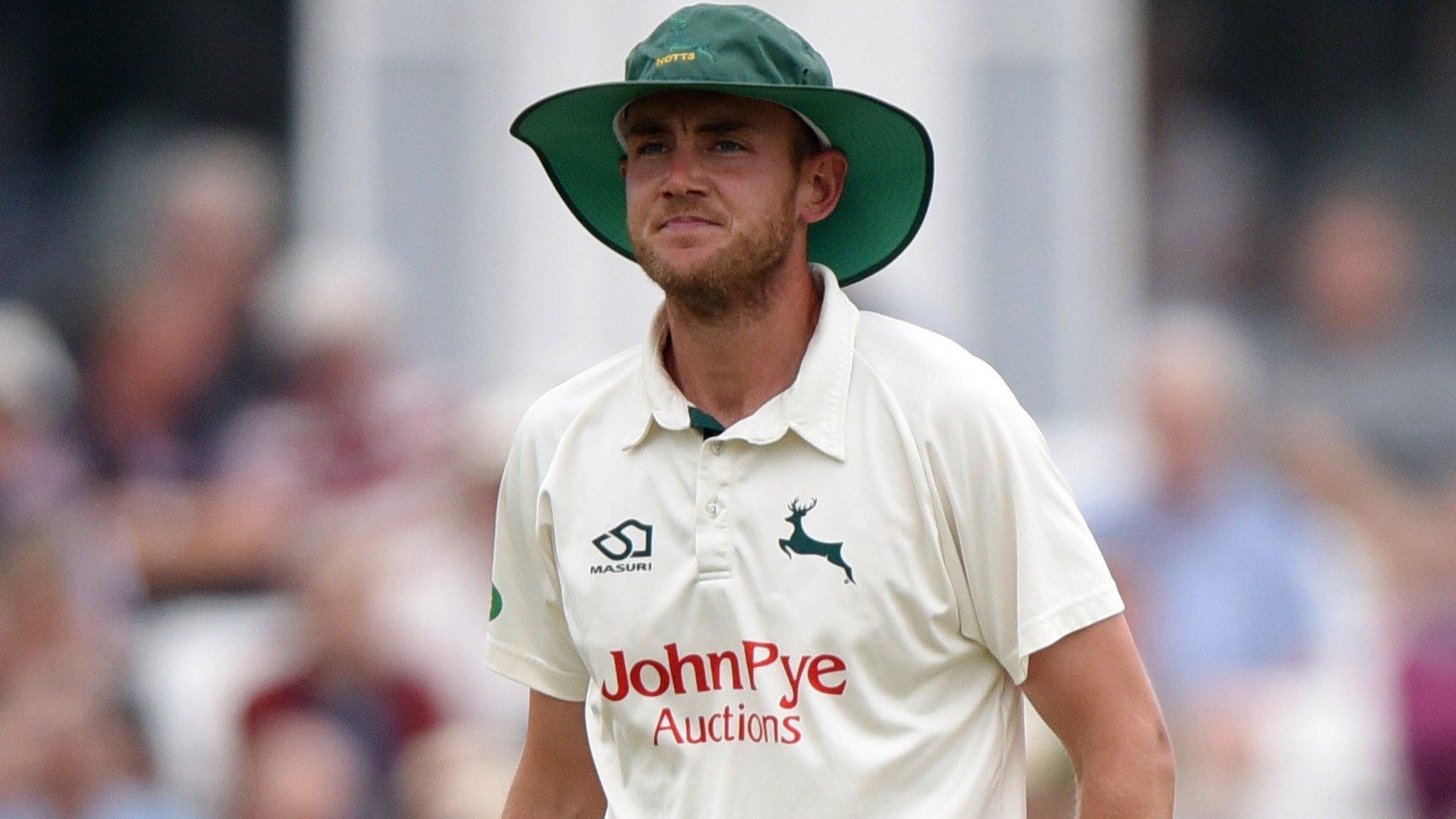County Championship: Day-night games provide Test warm-up for England stars
- Published

The annual pre-season champion county v MCC match is played on a day-night basis in Abu Dhabi
It was 23 July, 1997 when floodlit cricket first became part of the English county scene.
Warwickshire beat Somerset in front of 16,000 fans at Edgbaston, but that was a limited-overs game and it was to be 14 years before a day-night fixture was played in the County Championship.
Canterbury was the venue for a four-day contest in 2011 between Kent and Glamorgan, which the Welsh county won by eight wickets.
The game took place late in the season in September and despite free entry for the final 'night' session, attendances were poor and the experiment received a mixed response from players.
Six years on, and the England and Wales Cricket Board has sanctioned an entire round of Championship matches to be played on a day-night basis, using pink balls with black seams.
There will be nine matches in total, all beginning on Monday.
Why now?
There have been four day-night Test matches; three in Australia, and one between Pakistan and West Indies in Dubai.
England will play their first home day-night Test against West Indies at Edgbaston from 17-21 August.
"It was important for us to arrange a full round of fixtures to give our England players the chance to experience the conditions," said ECB chief executive Tom Harrison, when the Championship plan was announced last November.
"But just as we wanted to assess the impact of making Test cricket more accessible by changing the hours of play, the counties have really embraced the potential of Championship matches that stretch well into the evening when people have finished school or work."
England will also play a day-night Test in Adelaide in December as part of the 2017-18 Ashes series against Australia.
Stars come out under lights

Durham and England all-rounder Ben Stokes has had success under lights using white balls
Counties hope England's desire to give the Test squad a chance to experience day-night conditions will provide a revenue boost by increasing the chances of extra "bums on seats".
New Test captain Joe Root will be playing only his second Championship game of the summer as Yorkshire take on Surrey at Headingley, while star all-rounder Ben Stokes will be making his first four-day appearance for Durham, who are at home to Worcestershire.
Others, such as Alastair Cook, Stuart Broad and James Anderson, have seen plenty of their county team-mates in the past couple of months, although Broad will not play against Kent because of a heel injury.
Cook, in particular, has relished the opportunity, scoring 474 Championship runs at an average of 52.66 and hitting three One-Day Cup centuries - but will the change to a pink ball affect his form?
"If people are expecting it to behave in the same way as a red ball, they'll be disappointed," ECB director of cricket operations Alan Fordham told BBC 5 live sports extra.
"The easiest way to describe it is the pink ball is manufactured in the same way as a white ball, so it's not a ball that is easy to shine. You can perhaps get a little bit of a sheen on it but nothing like a red ball where you can get a really good polish on it, keep that lasting well and perhaps swinging into 40 or 50 overs. That's unlikely to happen."
How the format will work
All 18 counties will be involved in the first full round of day-night Championship fixtures, with four Division One games and five in Division Two.
Division One: Essex v Middlesex, Hampshire v Somerset, Warwickshire v Lancashire, Yorkshire v Surrey
Division Two: Durham v Worcestershire, Glamorgan v Derbyshire, Northamptonshire v Leicestershire, Nottinghamshire v Kent, Sussex v Gloucestershire
Play will start at 14:00 BST, with 'lunch' at 16:00 and 'tea' at 18:40 or later, depending on the over rates of the teams. The close should be at about 21:00 - although it is quite likely play could go on as late as 22:00 on some days if there are weather interruptions.
The pink balls will be a focus of attention, and they certainly were not to the liking of some players when Kent met Glamorgan in 2011.
"It was hard to see the ball, the colour wasn't quite right but I think they've sorted that out now, they've done a lot of trials and testing," former Glamorgan wicketkeeper Mark Wallace recalled last year.
Fordham is confident the new pink balls are much better, but added only limited research had been conducted.
"There comes a point where you can't keep playing with it in second XI cricket. We've got to get on and play it in a first-class game when we'll really begin to learn what's going on," he said.
"We'll be as interested as anybody to see how this pans out but we're confident that we've got a ball that will do a good job."
A one-off - or a regular feature?

Essex beat the West Indies in a floodlit limited-overs game at Chelsea's Stamford Bridge in 1980
The ECB will not make any firm decision on whether to schedule a similar round of day-night fixtures in 2018 until they have received feedback from the counties about this season's round of games.
Fordham says a wide expansion of the format is not really feasible, adding: "In this country, many of the grounds have floodlight planning restrictions which would not allow them to be used week after week in this form of cricket.
"It's probably likely people wouldn't want to be doing it in April or May or September anyway because the weather's not likely to be good enough in that third session.
"We may in county cricket end up being where we are [with one round of games], but if it's a success, there might be an opportunity for a county to play an extra game at home if they are able to do so. And I think that would be real progress."
And how will success be measured?
"I think whether more people are coming through the gate is one, but for me as a cricket person my biggest success measure will be having a form of cricket which is accepted by the players," he added.
"It will be different, it will introduce more skills, introduce more intrigue and if we achieve that, I think we'll have done really well."
What do the players think?
Lancashire and England pace bowler James Anderson: "I've had no experience with pink balls. I don't think the batsmen are hugely in favour of it.
"All the reports I've heard of day-night Test matches are that the twilight period is really difficult to bat in.
"It's great all the England players are available, not just because it's a pink-ball game, but a round of county games with all the England players available is a stronger one, and probably a more exciting one."
Surrey vice-captain Rory Burns told BBC Radio London: "It's an exciting, different challenge. We've been practising with the pink ball and getting used to it.
"It's a very different ball to the red ball, in how it reacts and the seam on it. With spin, you can't quite see the seam. That's one of the challenges.
"It feels a little bit lighter off the bat. The tougher periods will be when the floodlights come into play."
New Sussex captain Ben Brown told BBC Sussex: "It's history in the making. We're all going to be a small part of history.
"Whether it carries on and is the future of four-day cricket or not, it doesn't really matter. You'll always look back and talk about when you played against the pink ball under lights.
"The main thing will be how quickly we can react to the changing conditions, because it will be challenging."
'The ball looks cheap and nasty'
Northamptonshire head coach David Ripley told BBC Radio Northampton: "The balls look cheap and nasty to be honest - they don't look great compared to other balls that we use.
"But the proof will be in the pudding. At the moment, they haven't lasted very well. The colour will fade a little bit, but I still hope it will be fairly easy to see.
"It will be interesting to see how it goes. We're trying to be innovative in cricket. One round of games per year - I can see it catching on."
Durham head coach Jon Lewis told BBC Newcastle: "In England, with the long twilight period, it doesn't get dark quickly. It gets dark over a long period of time. That will have an effect as well.
"In Abu Dhabi, that period where the lights come on can be a bit spicy for the batsmen, but I don't think it's going to be the same here because it takes so long for the lights to take effect."

Geraint Jones (right), then Kent captain, examines the ball before a 2011 day-night match against Glamorgan
Analysis
Richard Wilford, BBC WM
Warwickshire were very much at the vanguard of day-night cricket in the shorter game, so it's only fitting that they are involved in this experiment.
Ahead of the county staging England's first day-night Test, it will be fascinating to see how the pink ball behaves in twilight conditions.
The second XI dress rehearsal last summer at Edgbaston saw significant movement in the latter part of the evening.
Therefore, the temptation may well be to declare with as much as an hour to play, even if sides are only seven or eight wickets down.
There's nothing to be lost from this journey into the unknown. Indeed, ticket sales for the England-West Indies Test match suggest that there is a public appetite to give it a go.
- Published23 June 2017

- Published25 November 2016

- Published15 September 2011